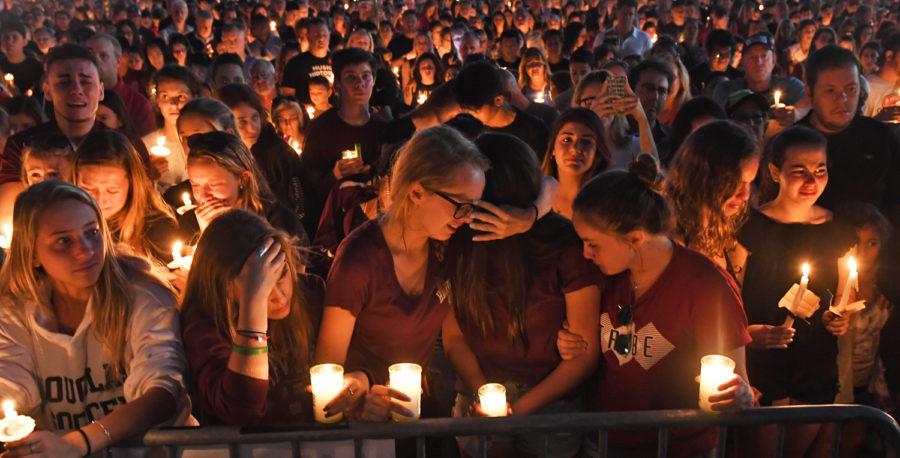Valentine’s Day is usually a holiday of showing care and appreciation for loved ones — but for many living in South Florida, it was a day of mourning and loss. February 14, 2018, just became a day marking one of the deadliest mass shootings in the United States.
Nikolas Cruz, a 19-year-old who had previously attended Marjory Stoneman Douglas High School in Parkland, Florida, is now facing charges for the murders of 14 students and three faculty, and the injury of 14 others from the high school.
Unfortunately, this is far from the first time an event like this has occurred. The Gun Violence Archive tracks reports of mass shootings — any incident where four or more people are shot. As of this most recent tragedy, they have reported 30 mass shootings in 2018.
Shootings that involve schools seem to be the most widely talked about because of the horror of targeting innocent children. Despite the attention, ever since shooters at Columbine High School killed 13 people in 1999, schools have become evermore frequent targets of mass public violence involving guns. Now there are 17 dead at at Marjory Stoneman Douglas High School — how many more deaths do we need to risk before a change starts to occur?
The United States continues to have far and away the highest rates of gun ownership among developed countries and some of the few restrictions — and Americans pay a price for it. Instead of focusing on what schools could be doing simply to minimize the dangers of gun violence, there’s a much simpler route to saving lives — enacting laws that prevent selling weapons of mass murder.
Much of the attention in the aftermath of last week’s massacre went toward the preventative measures in place at the Parkland high school that seemingly failed to avoid catastrophe — and in some ways even made the situation worse. In an interview with CNN the day after the attack, teacher Melissa Falkowski credited safety drills with saving some lives, but failing to protect every student.
“We could not have been more prepared for this situation, which is what makes it so frustrating,” Falkowski said. “We did everything that we were supposed to do.”
In last week’s shooting in Florida, the gunman pulled the fire alarm, sending all the students into the halls, before opening fire. Even if lockdown drills were effective, there would have been little recourse to prevent this tragedy from occuring.
There is no way to prepare for a catastrophe like this without regular routines and heavy security in the school. But a high school is not a prison and shouldn’t have to be treated like one. Checking bags, being patted down and having to study in fear every day shouldn’t be part of attending school. Basic restrictions on the kinds of guns available to the general public could help save countless lives, even if they don’t eliminate gun violence entirely.
During the attack, the shooter used an AR-15 — currently the most popular rifle in the United States, according to the National Rifle Association — and also happens to be the weapon of choice for five out of the six deadliest shootings over the last six years.
You don’t need to be a gun expert to understand a few basic facts about the AR-15. It’s a semi-automatic gun, meaning once a magazine has been loaded, the gun will fire each time the shooter pulls the trigger, without reloading, until the magazine is empty. Second, AR-15s are fed with easily swapped box magazines that usually contain around 30 bullets. And third — and most fatally — in Florida, it is easier to purchase an AR-15 than a handgun, The New York Times uncovered in the aftermath of last week’s shooting.
Originally developed to mimic a U.S. military weapon used in Vietnam, the AR-15 has been available to civilians for decades. But the weapon plainly designed for combat only really gained popularity in the aftermath of its use at a 1989 killing spree in a Stockton, California, elementary school. According Chris Bartocci, an author and former employee at gun manufacturer Colt Industries, the gun rapidly gained recognition because of its use in school shootings.
“Before Stockton, most people didn’t even know you could buy those guns,” Bartocci told CNN in a December 2017 interview.
To keep a rifle for shooting, hunting or home protection is one thing. But to allow for the sale of semi-automatic guns is another thing entirely. It’s clear that guns like the one used in Florida last week have much of their appeal because of their usefulness for mass murder.
Across the Pacific, a gunman killed 35 people in Australia in 1996. Within two weeks of the tragedy, the government took substantive legal measures in favor of limiting access to guns. What’s more, there hasn’t been a single mass shooting in the country in the 22 years since then.
The United States has the same capacity to end mass shootings. It’s just a matter of whether or not we’re willing to take the steps to do so. High school students in Florida have already staged protests against legislators’ inaction, and others across the country are planning mass exoduses from their classes in the upcoming months.
Ana primarily writes about culture and social issues. Write to Ana at [email protected].


